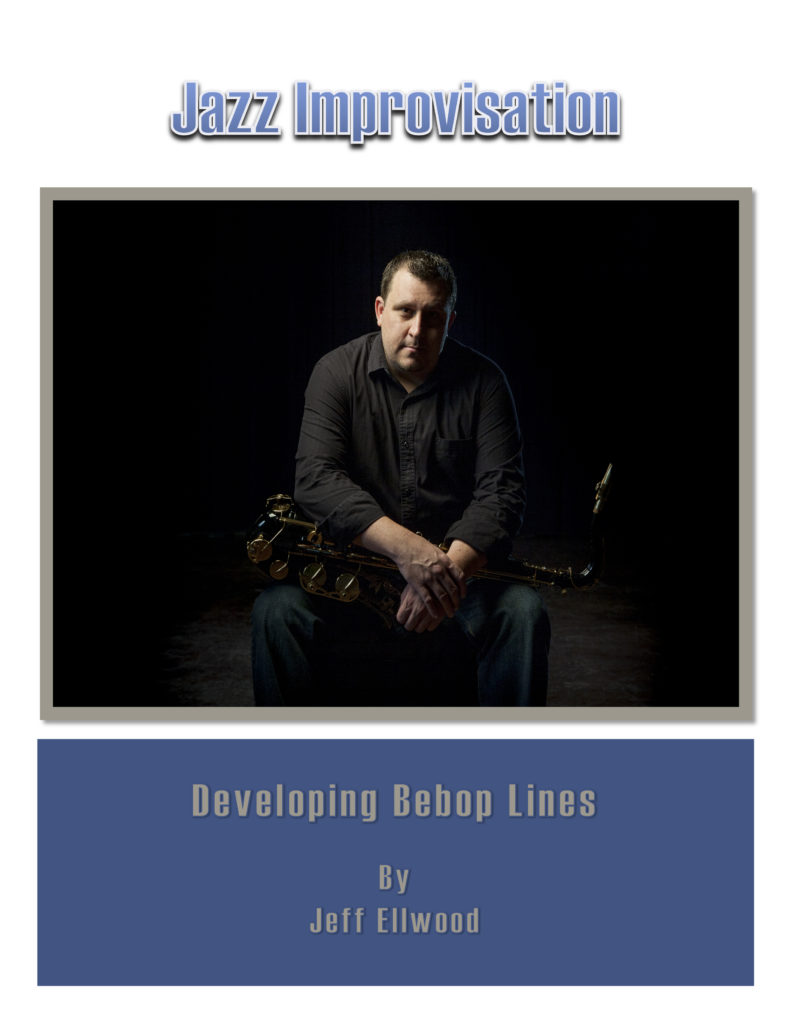
This is such a great book.
If you want to learn how you can create your own bebop lines, Jeff Ellwood has distilled the most important things in this book. This 58 page book is divided to 8 topics:
- Developing Bebop Lines
- Major Bebop Scales
- Resolving V7 to I
- Altered Bebop Scales
- Bebop Scales From Non-Primary Chord Tones
- Combining Diatonic 7ths with Bebop Scales
- Bebop using 4ths
- Etudes
Jeff Ellwood shares techniques and lesson that he created for his students in this book. With a combination of text explanations and extremely a lot of written musical examples, the book demystifies the basics of bebop lines.
For the serious student, there’s a lot of suggestions of how to learn the lines and create you own. This is very refreshing than some books that I’ve encountered where the material is too dry and academic. Also, rather than just giving many musical examples, Jeff Ellwood breaks down the elements so that the topics are easily digestible.
As I practice the material, I ended up working on a page for a long time. I particularly love the variety and detail that he goes into. So many of the lines open up new ways of varying and spicing up what I would typically do.
There’s so much value and Jeff Ellwood makes it even easier to see by writing the dominant examples all over G7 and the Major Bebop lines over Cmajor7 in the first 3 chapters. I love the fact that instead of making the book bigger by transposing all the examples in all 12 keys, Jeff Ellwood keeps it compact in this book in one key for entire chapters.
The 6 etudes included are a great part addition to the book as well since it gives more context for combining the different concepts in the book. To close the book, there’s also a great appendix with additional bebop scale exercises, octave displacements of the bebop scales and some bebop lines for fast tempos.
All in all, for USD$15, Jeff gives tremendous value and knowledge for aspiring jazz students interested in the bebop language.
Pros: Lots of examples, clear explanations on how to practice, how the lines and exercises are created and etudes for context
Cons: None.
TLDR: For any instrumentalist, if you want to learn to play bebop and are looking for some practical structure and exercises to augment your transcribing and jams, this is a good book to get.
How to Buy:
You can get the book here:
https://www.jeffellwood.net/developing-bebop-lines.html
[Read more Reviews]
Review #18
Review #17
Video Review: Essential Percussive Guitar Riffs with Jon Gomm
Review #16
Review #15
Video Review: 8 Sets of Jazz Blues Changes by Randy Johnston
Review #14
Book Review: The Thesaurus of Scale Tone Chords by Alex Rogowski
Review #13
Video Review: Bebop Flow – Connecting Harmonic Concepts with the Family of 4 by Sheryl Bailey
Review #12
Book Review: Improvising Without Scales – The Intervallic Guitar System of Carl Verheyen
Review #11
Review #10
Video Review: Dave Hill – Motif Development (Jazz Guitar Society)
Review #09
Book Review: A Guide to Developing a Chromatic Approach to Improvisation by Tony Greaves
Review #08
Review #07
Review #06
Review #05
Review #04
Review #03
Review #02
Review #01
[Submissions for Review Consideration]
- Are you an author who wrote a jazz, guitar or music book?
- Have you created a DVD or an online video course or subscription based website?
- Would you like me to review your book/course?
Please send me a message at azsamad2 at gmail.com with:
For courses: a link to the course/video/product + access info etc.
For books: a link to the book (Dropbox) or PDF attachment (if it’s small) for review consideration.
Depending on whether I dig the book/course, I’ll let you know if I do plan to review it!
I cannot guarantee a review for every submission & if I’m not too into it, I may opt not to review it. I mean, it’s better to get a good review that for me to write a bad review just because it’s not a match for the kind of stuff I dig right? :p
NOTE: All reviews reflect my honest personal opinion so be aware that I will point out both cool Pros and Cons that I see in the work. You dig? 🙂
Leave a Reply